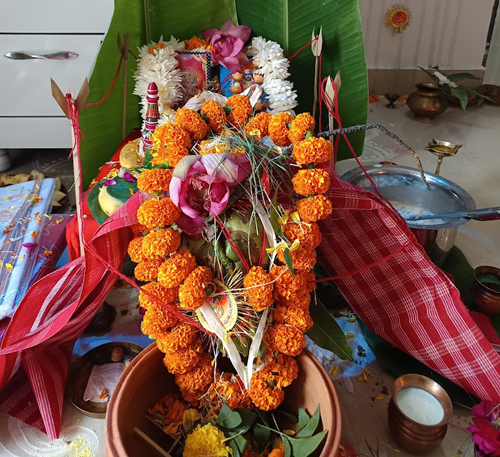
Satyanarayan Puja
Satyanarayan Puja is a highly revered Hindu ritual dedicated to Lord Vishnu, the preserver and protector of the universe in his benevolent form as Satyanarayan – the embodiment of truth and righteousness. This puja is performed to express gratitude, seek blessings for peace, prosperity, and to fulfill personal or family wishes.
It is traditionally conducted on Purnima (Full Moon) days, Ekadashi, special family occasions like marriages, housewarmings, or after achieving milestones. The puja involves Ganesh invocation, Kalash Sthapana, recitation of the Satyanarayan Katha, offering of Panchamrit and prasad (Sheera or Sooji Halwa), and aarti.
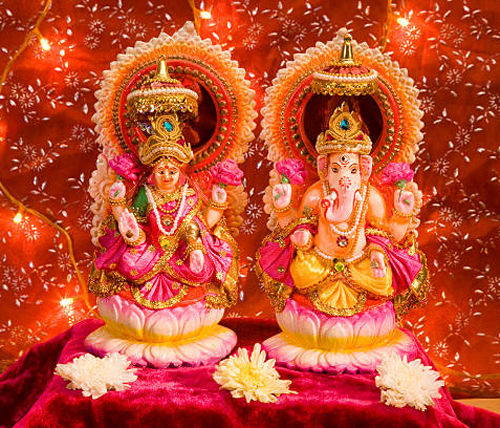
Lakshmi Ganesh Puja
Lakshmi Ganesh Puja is a popular and powerful ritual that invokes the combined blessings of Goddess Lakshmi, the deity of wealth and prosperity, and Lord Ganesha, the remover of obstacles and the god of wisdom and success. This puja is especially performed to invite fortune, harmony, and new beginnings in both personal and professional life.
Traditionally conducted during Diwali, business inaugurations, housewarmings, and important ventures, the puja includes Ganapati invocation, Lakshmi Sthapana, Shodashopachara puja, Lakshmi-Ganesh mantras, and aarti. Devotees offer sweets, lotus flowers, coins, and symbolic items to invite divine energy into their lives.
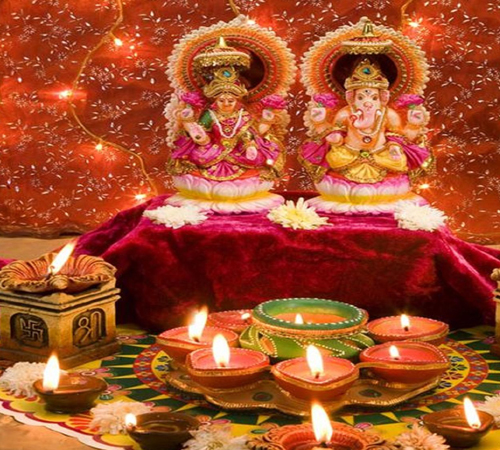
Diwali Puja
Diwali Puja is the central spiritual ritual of the Festival of Lights, performed to honor Goddess Lakshmi, the bestower of wealth and abundance, and Lord Ganesha, the remover of obstacles. This sacred puja marks the victory of light over darkness and good over evil, bringing peace, prosperity, and positivity into homes and hearts.
Performed on Diwali night (Amavasya), the puja includes cleaning and decorating the home, Lakshmi-Ganesh Puja, Dhan Lakshmi invocation, lighting diyas, chanting mantras, offering sweets, coins, and symbolic items, and aarti. Many also perform Kubera Puja and business account books (Chopda) Puja for wealth and success in the new financial year.
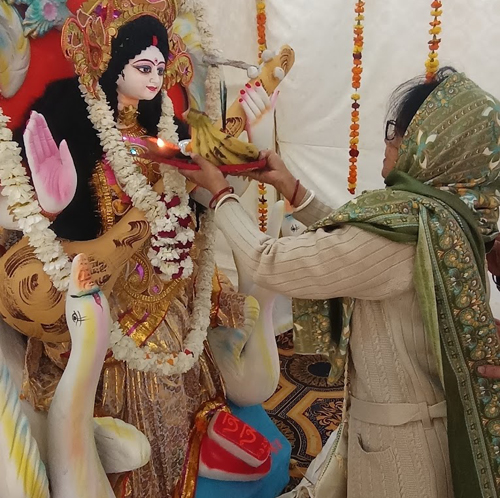
Saraswati Puja
Saraswati Puja is a sacred ritual dedicated to Goddess Saraswati, the divine embodiment of knowledge, wisdom, music, arts, and learning. Revered by students, teachers, artists, and scholars, this puja is performed to seek her blessings for intellectual growth, clarity, creativity, and success in education and the arts.
Traditionally observed during Vasant Panchami (Saraswati Jayanti) and also in the Navratri period, the puja includes Saraswati Avahan, installation of books and musical instruments near the idol, chanting of Saraswati Vandana and mantras, offering of white flowers, sweets, and yellow clothes, and aarti.
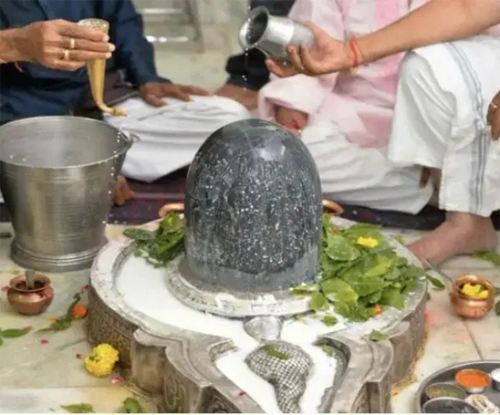
Rudraabhishek
Rudraabhishek is a powerful and ancient Vedic ritual performed to worship Lord Shiva in his fierce form as Rudra. This sacred abhishekam (ritual bathing of the Shiva Lingam) is accompanied by the chanting of the Sri Rudram from the Yajurveda, invoking divine energies to purify the soul, remove negative karma, and bestow health, prosperity, and inner strength.
The ritual involves bathing the Shiva Lingam with sacred items like milk, honey, curd, ghee, sugar, coconut water, bilva leaves, and water, while reciting Vedic mantras and Rudra chants. It is especially beneficial when performed on Mondays, Pradosham, Maha Shivratri, or during times of personal hardship or planetary afflictions (Doshas).
Rudraabhishek is ideal for those seeking mental peace, protection from enemies, spiritual growth, and relief from chronic issues – whether physical, emotional, or financial.
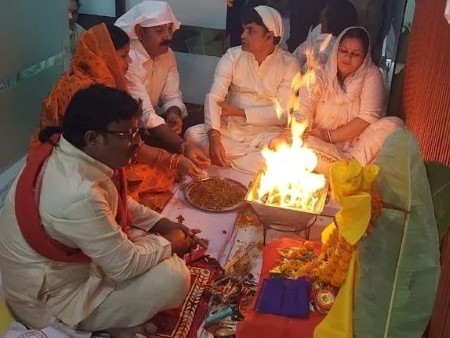
Havan (Homam)
Havan (also known as Homam) is an ancient Vedic fire ritual performed to invoke divine energies through sacred fire (Agni), which acts as a medium between the devotee and the deities. It is a spiritually purifying ceremony that removes negative energies, promotes well-being, and attracts peace, prosperity, and blessings into one's life.
During the Havan, offerings like ghee, grains, herbs, and wood are poured into the fire while chanting powerful Vedic mantras and sankalpa (intentions). The fire carries these offerings to the divine realms, purifying the environment and the soul.
There are various types of Havans, each with specific intentions, such as:
1- Ganapati Havan for obstacle removal
2- Navagraha Havan for planetary balance
3- Maha Mrityunjaya Havan for health and protection
4- Sudarshan Havan for protection and energy cleansing
5- Lakshmi Kubera Havan for wealth and abundance
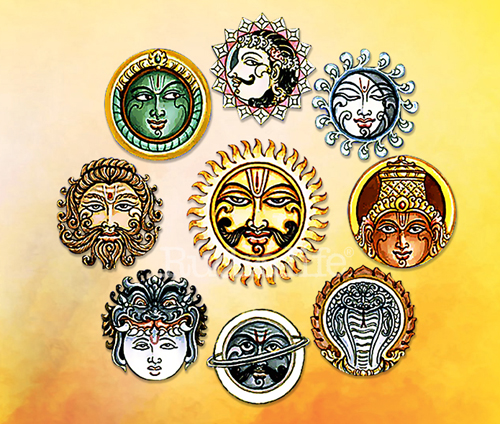
Navagraha Shanti Puja
Navagraha Shanti Puja is a powerful Vedic ritual performed to pacify the nine celestial influencers (Navagrahas): Surya (Sun), Chandra (Moon), Mangal (Mars), Budh (Mercury), Guru (Jupiter), Shukra (Venus), Shani (Saturn), Rahu, and Ketu. These planets govern various aspects of life including career, health, relationships, finances, and spiritual growth.
When malefic planetary positions or Doshas (like Shani Dosh, Rahu-Ketu Dosh, Manglik Dosh) are present in one's horoscope, they can cause challenges and instability. Navagraha Shanti Puja helps to neutralize these effects, align planetary energies, and bring harmony to life.
The puja includes Sankalpa (intention setting), Navagraha mantra japa, Havan (fire ritual), Yantra sthapana, and graha daan (planetary donations), all performed with strict Vedic procedures.
Ideal during:
1- Major life events (marriage, childbirth, job changes)
2- During or after Sade Sati, Dasha periods, or eclipses
3- For ongoing struggles in health, finances, or relationships

Mangal Dosh Puja
Mangal Dosh Puja, also known as Manglik Dosh Nivaran Puja, is a powerful Vedic remedy performed to reduce the negative effects of Mangal Dosh (Mars affliction) in one's horoscope. This dosh occurs when Mars is positioned unfavorably in certain houses of the birth chart, often causing delays or problems in marriage, relationships, health, and finances.
Mars is a fiery planet associated with energy, aggression, and ambition. When imbalanced, it can lead to conflicts, separations, and instability in personal and marital life. This puja helps to calm Mars, bring emotional balance, and restore harmony.
The ritual includes Ganapati Puja, Mangal Graha Shanti Mantra Japa, Mangal Havan (Fire Ritual), Mangal Yantra Sthapana, and offering of red items, such as red flowers, red lentils, and pomegranate to the deity.
Ideal for:
1- Individuals with Manglik Dosha before marriage
2- Couples facing marital discord or frequent quarrels
3- People experiencing obstacles in marriage proposals or relationship commitments
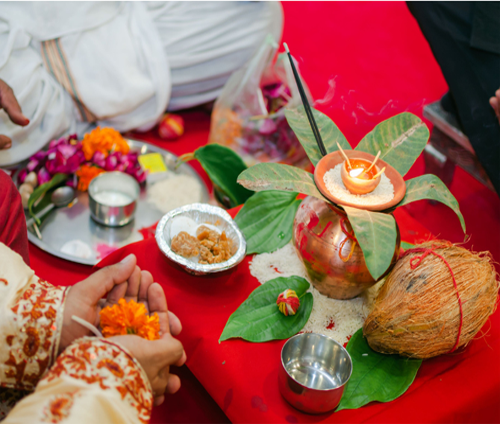
Pitra Dosh Puja
Pitra Dosh Puja is a sacred Vedic ritual performed to pacify the souls of departed ancestors and seek their blessings. Pitra Dosh arises in a person’s horoscope due to unfulfilled desires, karmic debts, or improper last rites of forefathers. This dosh can result in obstacles such as delayed marriage, health issues, financial instability, family disputes, or repeated misfortunes.
This puja helps to clear ancestral karmic blockages, bring peace to the departed souls, and restore harmony and progress in the family lineage. It is considered especially important for those who experience recurring setbacks despite sincere efforts.
The ritual includes:
1- Tarpan (water and sesame offerings)
2- Pind Daan for ancestral liberation
3- Shraddha rituals
4- Havan and mantra chanting dedicated to ancestors
5- Offering food and donations to Brahmins and the needy

